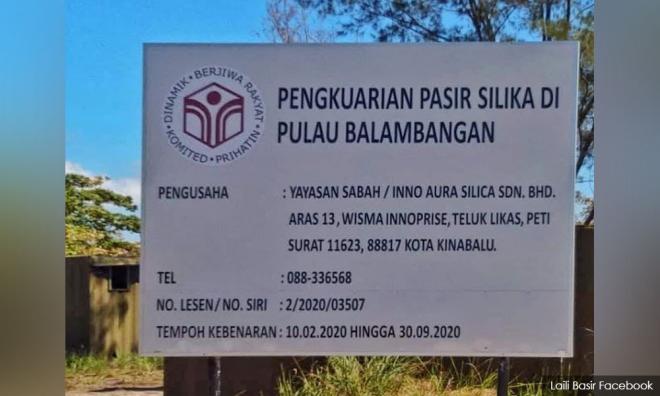
A coalition of environmental groups is raising alarm that work has started on a silica mining project on Pulau Bambangan off Kudat, even though no environmental impact assessment (EIA) has been submitted.
In a letter to the Environment Protection Department last week, the coalition said piling work has begun while structures have been put up in the peninsular of the island, deemed “very important in geoheritage conservation”.
Besides biodiversity, the island is also the site of World War II artefacts, including unexploded bombs, presenting a risk for mine workers, it said.
“As members of the civil society and research community in Sabah and Malaysia, we urge you to investigate this matter urgently; the indiscriminate destruction of Balambangan Island, part of Tun Mustapha Marine Park is of regional and global concern,” the group said.
The group also noted how vacancies have been advertised for the project, indicating work will continue despite what conservationists believe could be an irreversible loss of biodiversity and other heritage in the area.
The letter was sent by 3H Coalition, which comprises Bornean Sun Bear Conservation Centre (BSBCC), Borneo Futures, Danau Girang Field Centre (DGFC), Forever Sabah, Land Empowerment Animals People (LEAP), Pacos Trust and WWF-Malaysia.
The project is a joint venture between state foundation Yayasan Sabah and Syarikat Sebangun Sdn Bhd, a subsidiary of the Sarawak conglomerate, KTS Group.
Malaysiakini has contacted caretaker Sabah Tourism Minister Christina Liew for comment.
Shafie: Mining won’t have serious impact
Last October, Liew said the EIA for the project had yet been obtained but she is confident the Environment Protection Department would ensure the project complies with all requirements before work can start.

Chief Minister Shafie Apdal also said the silica mining project on Pulau Balambangan would have minimal impact because the island is isolated.
“If there is any kind of sand extraction coming from that area, it will not affect the environment nearby,” he was quoted by The Star as saying.
The project is also part of the state’s attempt to reduce reliance on oil and gas and tourism revenue, he said.
“This is one sector of revenue we cannot forgo...We know the silica sand mining is not going to have a serious impact in terms of pollution,” he reportedly said.
WWF-Malaysia, which has opposed similar plans for more than a decade, however, said the blasting would hurt the surrounding coral reef in one of the state’s richest fish breeding grounds.
Prehistoric artefacts
In 2007, the state had proposed a clinker and grinding plant for cement using the limestone deposits on the island but this did not materialise. At the time, the state said it was studying ways to balance the project and conservation.
In a technical report in 2011, WWF-Malaysia found conserving the entire Tun Mustapha Marine Park, which includes Pulau Balambangan, could generate an income of about RM343 million through ecotourism while the proposed silica and limestone mining would only rake in about RM100 million.
The island also holds historical value, with previous archaeological digs discovering prehistoric human bones and artefacts dating back to the Ice Age.
It was also used as a trading post by the East India Company in the 1700s.
A 2008 study by Universiti Kebangsaan Malaysia said Pulau Balambangan had “outstanding scientific, aesthetic and cultural values that make the island very important in terms of geoheritage conservation”. - Mkini


No comments:
Post a Comment
Note: Only a member of this blog may post a comment.